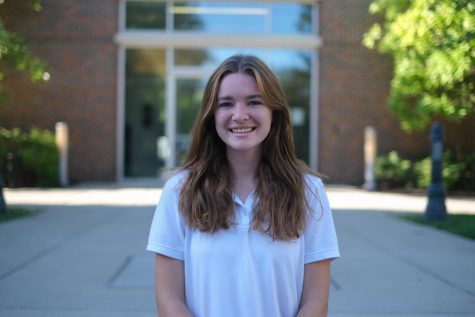STA Sisterhood: Past and Present
Although St. Teresa’s Academy has evolved and grown over the years, its cornerstones have held true. STA continues to empower students decade after decade while instilling the importance of continuing the legacy and valuing age old traditions.
September 24, 2021
“I always say it with pride that I have gone to St. Teresa’s Academy,” Katie Gadwood, class of 1981 said.
St. Teresa’s Academy is a high school with a profound history which is best told through the experiences of its alumnae.
Alumnae, whether graduating 50 years or 20 years ago, agree that the college campus feel was something that elevated STA from other high schools. When class of 1977 graduate Julie Holmquist revisits her old STA memories, she fondly remembers the school’s unconventional teaching style.
“The structure of the classrooms was bridging you to this notion of campus feel,” Holmquist said.
A common theme shared among the different decades of alumnae was acceptance and empowerment as a woman in the classroom. Class of 2000 graduate Caroline Mudd believes that STA helped her develop her confidence.
“I never felt like if you said the wrong thing in class it was ever a big deal; no embarrassment at all, which is really important,” Mudd said.
“With an all-girls environment, you can be so genuine right from the start. That sort of pressure is off of you from day one.”
The faculty and staff at STA played a major role in shaping class of 2014 graduate Elena Flores’s high school experience.
“My teachers were really great at building confidence within us; I participated a lot in my classes because I felt I had the opportunity to,” Flores said.
Class of 2017 graduate Ellie Grever also appreciated her teachers at STA.
“The teachers treated you like equals as well, which is a lot different than grade school, and it’s kind of the first time you feel like that,” Grever said.
However, the progression of material taught at STA changed even throughout only 20 or so years. According to class of 1955 graduate Mary Ellen Devine, in the 50s for example, the focus was more on core values.
“They (nuns) wanted to keep us close to God,” Devine said.
“They weren’t necessarily highly educated but they taught us to be loyal to each other, to be respectful to our parents, to other people and to live every day of our lives as Catholic girls.”
20 years later, during the free-spirited 70s, contemporary classes were beginning to pop up between the school’s staple curriculum offerings.
“You took shorthand, you could take four years of typing, and yet they had these really pretty revolutionary classes on pro-women at the same time, so it was a time of change,” Holmquist said.
The buildings themselves changed as well. In the 50s there were only two buildings, what today is M&A was the high school building, and what today is Donnelly was the college of St. Teresa. The Windmoor and Goppert buildings did not exist at all.
School sports at STA, along with school spirit, have evolved as well throughout the years. Recent alumnae report a sports-positive culture, but this wasn’t always the case at STA. In the 50s, gym class was a dreaded necessity.
“Our gym teacher was Pauline Reardon, and she either liked you or not and if you were a jock she liked you and if you didn’t, tough,” Devine said.
Four years of gym class along with specific gym uniforms were required.
“We had to have these bubble white suits, and we had to have our name on them, and that’s what we wore for P.E.; they were hideous, but they were funny, and we still talk about it to this day,” Gadwood said.
“They sat in our lockers for the whole year so even though they were white they looked grey,” Devine said.
Today’s students along with recently graduated alumnae report that sports and school spirit are a huge part of the STA experience.
“School spirit was crazy, it was competitive, it was contagious,” Flores said.
Many STA students today enjoy going to various school sporting events and cheering on our teams. This is similar to Mudd’s experience.
“I remember the stadiums would be packed, especially if we were playing Sion,” Mudd said.
But school spirit is more than just the sports themselves.
“It [school spirit] gave me life, it gave me energy, and not just at the sporting events, tying it back to the culture of St. Teresa’s. It was just very energetic, very lively,” Flores said.
“People had a special school spirit that they carried around with them and that manifested in different ways.”
Alumnae advice is to try a sport if you can.
“The advice that everybody gave when you first came in was ‘try to do a sport,’ and I never did, and I really wish I had; that would be my advice, give it a shot,” Mudd said.
One of STA’s longest standing traditions is that of the class ring. Every STA student has the chance to receive a STA class ring, and for many alumnae, this ring, along with its tradition, holds a deep significance.
“[The class ring tradition] was a symbol of our accomplishments, that we had worked hard in school and we had worked hard with our friendships,” Gadwood said.
For Flores, her class ring still comes with her everywhere and has allowed her to make new connections to STA even years after she graduated.
“I find that throughout college and post-grad life it is a talking point; people point it out and ask me about it so I feel like wearing my ring constantly reminds me of St. Teresa’s,” Flores said.
“I specifically love that tradition of the ring and I’m reminded about it every other week because it comes up in conversation in some form or fashion.”
This tradition is special to many alumnae, even those who no longer have their ring, such as Devine.
“I don’t even really know what happened to it and I’m very sentimental so the fact that I don’t have it is sad,” Devine said.
There are even some STA traditions that, according to Devine, were well loved but have now been forgotten with the passage of time. Where the Windmoor building now stands is the sight of the beloved tradition of the state of the blessed mother. In May students would have May crown, they would all parade around the quad and then they would crown the blessed mother.
“It was just beautiful and it was a lovely ceremony so when they built that building (Windmoor), those of us that knew that tradition, even though they kept the grotto of the blessed mother, it was not what it was in our time,” Devine said.
“There was a song we sang, I doubt you still sing it, ‘the friendships we made at STA will live on forever and a day’,” Devine said.
Teresian and other school dances are a typical part of high school life and STA culture. Because of the cancellation of last year’s Teresian due to COVID-19 restrictions, for many current STA students, this year’s Teresian tomorrow night will be their first. Dances at STA have always been special but they have also changed throughout the decades. In the 50s, Teresian was held in what is now the auditorium in M&A and nuns who worked at STA would heavily chaperone the dance.
“The nuns would all be lined up all around the top part (of the auditorium), and they would critique the clothes we had on to make sure they were modest,” Devine said.
Devine says she and her STA sisters managed to have fun despite the nuns’ watchful glare.
“We danced all the time — that was a great thing about our generation; we had great music and we danced,” Devine said.
60 years later in 2014, there were no longer nuns supervising the dance but the school spirit remained. “The school spirit people had, they brought it to the dances, they brought it to Teresian, and they would also bring it to other schools dances as well,” Flores said.
“If you were at another school’s dance you could always count on the STA girls who were all dancing, they were singing, they were dancing like nobody was watching.”
The forbidden “haunted” fourth floor of M&A is often joked about among current students because of its history of housing the nuns, the Sisters of St. Joseph of Carondelet, who taught in STA’s halls until 2016. But what was going to school with these nuns really like? For Devine, the nuns were tough.
“They ruled with an iron thumb; by God, you didn’t cross those nuns,” Devine said.
“I don’t think they’re too many of us that didn’t get caught by a nun whose class was beyond boring and we’re writing notes to each other in class and the nun will be talking, going behind us and getting the note out and reading it to the whole class.”
Despite the nuns’ strict practices, class of 1962 graduate Cathy Marx says, they were well liked.
“I was very fond of all the nuns, and all of our teachers were nuns except three,” Marx said.
At the same time though, the nuns taught STA students valuable lessons in morals that they took with them throughout the rest of their lives.
“[The nuns] used to tell us, if you were half the women your mothers were, and that we always esteemed to something,” Devine said.
By the 70s, the role the nuns played was shifting.
“As women are evolving and the position women are in are evolving, nuns were doing the same thing,” Holmquist said.
“To have a class when you’re in high school that’s called women in studies and it’s taught by liberal nuns, you’re supposed to take a liberal perspective of it. Which is really pretty revolutionary for conservative women. You went to a conservative grade school, and suddenly you get these nuns that are evolving as you are.”
The sisterhood of STA is very important for this generation of students. As STA president Siabhan May-Washington said in her president’s welcome, we all share in the “sisterhood of the Academy.” All alumnae agreed that sisterhood is an integral and distinctive part of the STA experience.
“The powerfulness of women was always prevalent; I was always seeing it and I was always inspired by it,” Flores said.
Inclusivity as well as feeling a part of one big group of sisters made up of STA classmates was one factor.
“I felt as though everybody said, come in our group, hang out with us, this’ll be fun, go with us to this dance; I just really felt as though everybody was very inclusive,” Holmquist said.
Mudd agreed, adding that she still runs into her fellow classmates often.
“Even with girls that weren’t in your core group of friends, there’s always that connection, and whenever I see them it’s like no time has passed,” Mudd said.
School reunions help keep this connection strong by allowing alumnae to come together once again. STA’s very first black student, class of 1955 graduate Rita Hall Cloud, will be in town for her 65th reunion October 9th. She will also be honored as the first black alumna on Thursday, October 7th.
Connection through shared faith also played a role.
“Throughout high school I loved the idea that my classmates, that the women next to me were my sisters; the idea of being a sister in Christ,” Flores said.
“Sisterhood means a lot; it means community, it means relationship, it means purpose, it means family.”





